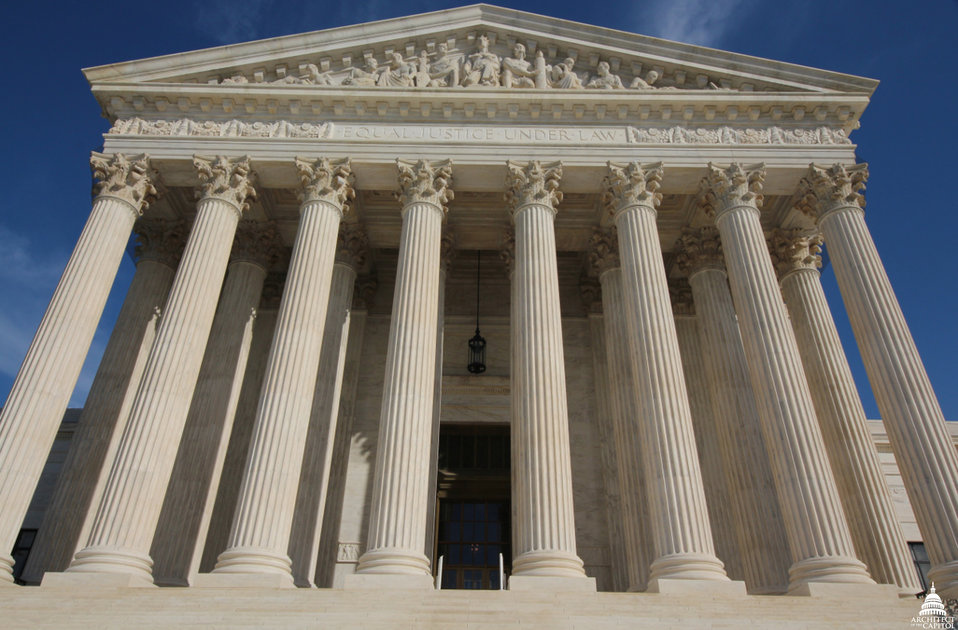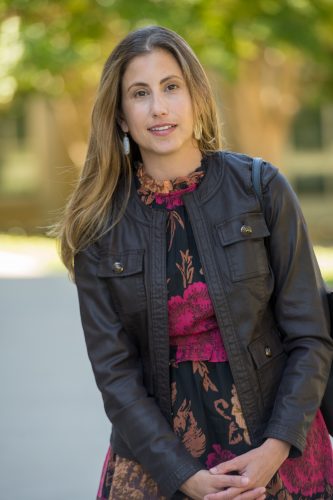
Courtesy of Architect of the Capitol/Public Domain
U.S. Supreme Court Justices Use Social Science Research in Rulings
Michele Meitl found that judges cite research to add credibility and transparency to decisions.
In criminal court cases, bigger is considered better.
The assumption is a result of a 1978 case in which the U.S. Supreme Court relied on 25 evidence-based studies on the effect of group size on jury deliberations.
In that case, Ballew v. Georgia, the court determined that a five-person criminal jury was unconstitutional, which turned the tide to allow for today’s 12-person juries. Justice Harry Blackmun wrote in the court’s opinion that “a criminal trial to a jury of less than six people substantially threatens Sixth and 14th Amendment guarantees” to a fair and speedy jury trial because research suggested smaller juries are “less likely to foster effective group deliberation.”

In a 2020 study, Michele Meitl found that U.S. Supreme Court justices often use social science research to add credibility, transparency and accountability to their decisions. Photo by Leo Wesson
For more than 100 years, the U.S. Supreme Court has been using social science research to support its decisions. Michele Meitl, an assistant professor of criminal justice, found that justices are using insights from psychology, sociology, criminal justice, economics and political science much more often in the 21st century.
From 2001 to 2015, 40 percent of written opinions from the nation’s highest court included a nod to social science research, according to Meitl’s 2020 study, which was published in Social Science Journal. That’s up from 14 percent in 1990 and 10 percent in 1978.
Realizing their decisions can have far-reaching impacts on Americans’ daily lives, the justices often turn to academic research to help them better understand complex issues and lend more credibility, transparency and accountability to their opinions, Meitl said.
“They’re experts in law and precedent, but they may not be experts in brain development or [jury] deliberation,” she said. “They look to the outside world … to inform them of these things.”
Justices have turned to academic research to support their views on issues like the risk of discrimination in the jury selection process and the ability of young people to understand their Miranda rights.
In a 2005 ruling requiring police enforcement of restraining orders in domestic violence cases, the Supreme Court cited data from the Pace Law Review that mandatory arrests in New York City from 1993 to 1999 rose 114 percent for misdemeanor domestic violence, 76 percent for violation of protection orders and 33 percent for felony domestic violence.
Meitl noted in the study that some justices even “took a trip to the law library to look at the difficulty kids might have getting onto inappropriate websites” in relation to an internet obscenity case.
Far-Reaching Impact
While Meitl analyzed written opinions only in criminal procedure cases, she said her findings on the relationship between research and law are relevant to all cases.
To illustrate: In 1954’s landmark Brown v. Board of Education case, the Supreme Court opinion referenced several psychological studies that showed how racial segregation caused social and psychological harm to Black schoolchildren.
In a 2021 free speech case, the concurring written opinion used data from the National Center for Education Statistics to support the court’s decision that a Pennsylvania high school’s disciplinary measures taken because of a student’s off-campus social media posts violated her First Amendment rights.
During the current term, which ends in June 2022, the high court is reviewing Texas and Mississippi cases that could overturn much of Roe v. Wade, the 1973 decision affirming a woman’s right to abortion. If the justices rely on research to examine the impact of abortion restrictions, Meitl said, “they could use studies to show that more restrictions mean women may seek more dangerous methods.”
She also said the U.S. Supreme Court has become more conservative since 2015, which may make a difference because “Republicans generally use social science less frequently.”
Her study found that Democratic justices, such as Stephen Breyer and Sonia Sotomayor, cited social science in 34 percent of their opinions, compared with 20 percent for Republican justices, such as Clarence Thomas and Antonin Scalia.
A Different Point of View
Meitl, a licensed attorney, worked for nearly a decade in the legal profession in Washington, D.C., including as a staff attorney for the American Bar Association’s Death Penalty Representation Project.
“I knew I wanted to stay in that lane [for research] and look at courts and appeal,” said Meitl, who often visited the Supreme Court to listen to oral arguments. “I love the court.”
Nicole Leeper Piquero, a professor of sociology at the University of Miami in Florida and Meitl’s dissertation chair while both were at the University of Texas at Dallas, said it’s rare for a criminal justice professor to also have a law degree. The combination allows Meitl to look at criminology in a fresh way and makes her good at asking questions, which is important to research, Piquero said.
“She’s approaching the same question from different angles,” Piquero said. “She has a unique view to bring those worlds together. She sees both perspectives and how they can help each other.”
A Library for Law
In 2020, Meitl delved deeper to examine what types of research justices cited most often.
“Social science is always open to interpretation and building on studies to clarify something. With law, it’s precedent: This is how it was done in the past and how it should be followed.”
Michele Meitl
She found that every justice cited social science research at least once in 168 cases between 2001 and 2015. She also discovered the No. 1 type of research cited by justices appeared in law journals (37 percent), followed by peer-reviewed articles (24 percent), government reports (17 percent) and books (14 percent).
Justices tend to rely more on law journal articles because they “are more comfortable” with that format, Meitl said. “That’s what they read in law school. … Many of the other citations we’re starting to see more of, the justices consider them to be more wishy-washy.”
The Supreme Court can still be skeptical about the relevance of academic work to its rulings, Meitl said, citing 2017’s Gill v. Whitford. In that case, plaintiffs charged that a Wisconsin redistricting plan adopted by the state’s Republican-controlled legislature was unconstitutional because it unfairly favored the ruling party. During oral arguments, a lawyer implored the justices to use data analytics to show that such partisan gerrymandering could become a “more serious problem.”
Chief Justice John Roberts called the attorney’s numbers “sociological gobbledygook.”
“Social science and law are very different,” Meitl said. “Social science is always open to interpretation and building on studies to clarify something. With law, it’s precedent: This is how it was done in the past and how it should be followed.”
Meitl’s research shines a light on how well academics and scientists communicate the validity of their research. But the jury still is out on whether Supreme Court justices will continue to rely more on research to support their decisions.
For that to happen, Meitl said academic research must be more accessible to a wide swath of people. “Quality research is important and can make a big difference,” she said. “It’s important that we make it understandable and accessible to the outside world if we want it to have an impact on the court and policy.”

Your comments are welcome
Comments
Related reading:
Amorette Hinderaker: For the Sake of Argument
Expanding perspectives is one way to lead discourse, she says.
Alumni, Features
A Public Defender’s Fight for a Man’s Freedom
Attorney John Thomas’ innovative defense and commitment to his cause helped his client’s release.